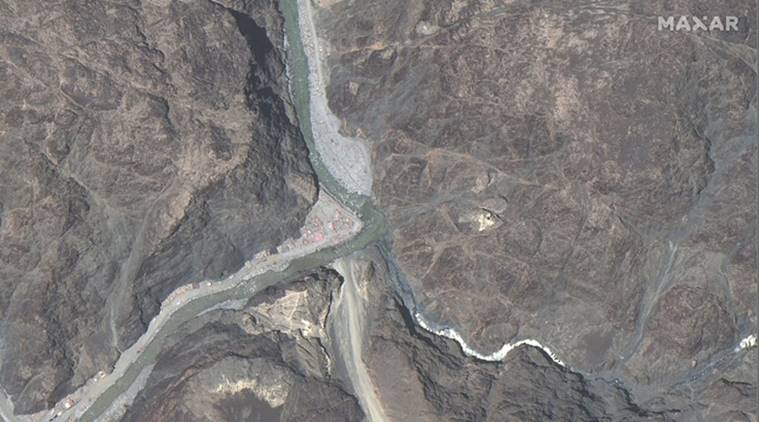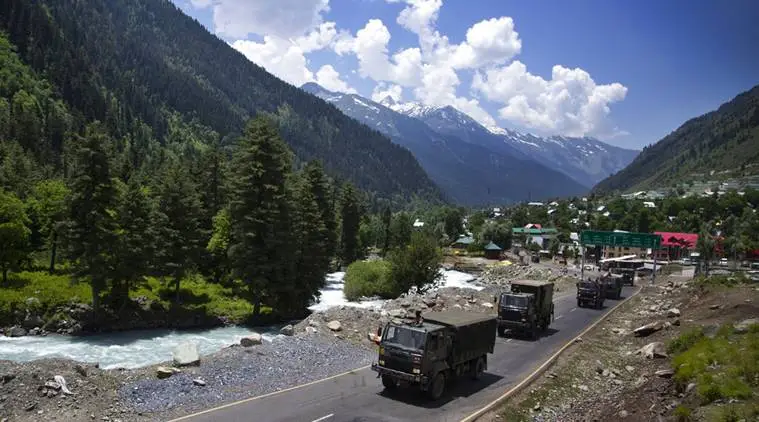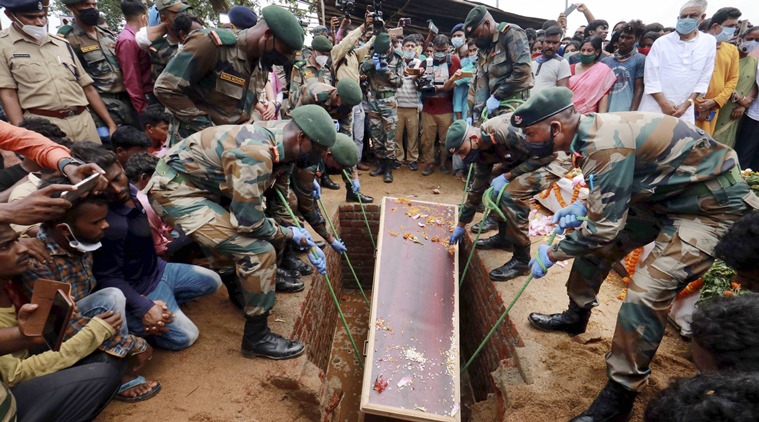 Maxar WorldView-3 satellite image shows area near the Line of Actual Control (LAC) and Patrolling Point 14 in the eastern Ladakh sector June 22, 2020. (Maxar Technologies via Reuters)
Maxar WorldView-3 satellite image shows area near the Line of Actual Control (LAC) and Patrolling Point 14 in the eastern Ladakh sector June 22, 2020. (Maxar Technologies via Reuters)
India-China Border News: Holding Beijing responsible for the violent faceoff in the Galwan Valley of Ladakh, the Ministry of External Affairs (MEA) Thursday said that China has been amassing a large contingent of troops and armaments along the Line of Actual Control (LAC) since early May and that the conduct of Chinese forces has been in “complete disregard of all mutually agreed norms”.
India-China Border News Live Updates
“At the heart of the matter is that since early May, the Chinese side has been amassing a large contingent of troops and armaments along the LAC,” said MEA spokesperson Anurag Srivastava. “This is not in accordance with the provisions of our various bilateral agreements, especially the key 1993 Agreement on the Maintenance of Peace and Tranquility along the Line of Actual Control in the India-China Border Areas.”
The Indian side, the MEA said, had to obviously undertake counter deployments and that “the resulting tension has thereafter expressed itself”. On Wednesday, the Chinese Defence Ministry had echoed Beijing’s claim to the Galwan Valley. That was the first time that the Chinese armed forces staked claim to an area that is well within Indian territory. To this, the MEA said, “The deployment of large body of troops and changes in behaviour has also been aggravated by unjustified and untenable claims. The recent shift in the Chinese position on the Galwan Valley is one example.”
New satellite images have revealed Chinese structures back at Galwan Valley, the site of the June 15 clashes that left 20 Indian soldiers dead. Top sources in the Army told The Indian Express “the tent which was removed on June 15 has been reported back by our ground troops at PP-14 (Patrolling Point 14)”. The structures have been built between June 16 and June 22 because Planet Labs satellite images of the location on June 16, a day after the clashes, do not show any such infrastructure.
 India-China border news live updates: An Indian Army convoy moves on the Srinagar-Ladakh highway at Gagangeer, northeast of Srinagar. (AP Photo)
India-China border news live updates: An Indian Army convoy moves on the Srinagar-Ladakh highway at Gagangeer, northeast of Srinagar. (AP Photo) Army personnel bury the mortal remains of Rajesh Orang during his funeral ceremony, at Belgoria village in Birbhum district of West Bengal, Friday, June 19, 2020. (PTI Photo)
Army personnel bury the mortal remains of Rajesh Orang during his funeral ceremony, at Belgoria village in Birbhum district of West Bengal, Friday, June 19, 2020. (PTI Photo)
Indian and Chinese troops had their first faceoff in the Galwan Valley in the first week of May, around the time they came to blows on the banks of the Pangong Tso, and more than a month before the June 15 showdown in Galwan Valley in which 20 Indian Army personnel were killed. This came to light Thursday when the Ministry of External Affairs mentioned it for the first time and the Chinese Ambassador to India, Sun Weidong, detailed the incident in an interview to PTI, a transcript of which was posted by the Chinese embassy. Read Krishn Kaushik and Shubhajit Roy's report
Describing the Wednesday meeting between diplomats under the Working Mechanism for Consultation & Coordination on India-China Border Affairs (WMCC) as a “significant development” and referring to the agreements and understanding reached between the Foreign Ministers on June 17 and Army Commanders on June 6 and 22, MEA spokesperson Anurag Srivastava said, “We expect the Chinese side to sincerely follow up on this understanding and ensure the expeditious restoration of peace and tranquility in the border areas.”
At an online media briefing, External Affairs Ministry Spokesperson Anurag Srivastava gave a run down of the events along the LAC in the eastern Ladakh region and held China responsible for the Galwan Valley clashes off June 15.
The Ministry of External Affairs (MEA) stated that the Indian side had to undertake counter deployments after China started amassing a large contingent of troops and armaments along the Line of Actual Control (LAC) since early May.
"At the heart of the matter is that since early May, the Chinese side has been amassing a large contingent of troops and armaments along the LAC," said MEA spokesperson Anurag Srivastava. "This is not in accordance with the provisions of our various bilateral agreements, especially the key 1993 Agreement on the Maintenance of Peace and Tranquility along the Line of Actual Control in the India-China Border Areas."
"This notes in particular that ‘each side will keep its military forces in the areas along the line of actual control to a minimum level compatible with friendly and good neighbourly relations between the two countries’," he said, adding, "Obviously, the Indian side had to undertake counter deployments and the resulting tension has thereafter expressed itself."
Admiral Arun Prakash (Retd), former Chief of Naval Staff, in his piece for The Indian Express, writes: "At the ground-level, we need to visibly reinforce our positions, and move forward to the LAC all along, enhancing the operational-tempo of the three services as a measure of deterrence. Indian warships should show heightened presence at the Indian Ocean choke-points. Cyber emergency response teams country-wide should remain on high alert. While building-up stocks of weapons, ammunition and spares, the Ministry of Defence should seize this opportunity to urgently launch some long-term “atma-nirbharta” schemes in defence-production."
"At the strategic level, the government must moot a sustained process of engagement with China at the highest politico-diplomatic echelons. The negotiations should seek multi-dimensional Sino-Indian modus-vivendi; encompassing the full gamut of bilateral issues like trade, territorial disputes, border-management and security. Simultaneously, at the grand-strategic level, India should initiate a dialogue for the formation of an “Indo-Pacific Concord for Peace and Tranquility”, inviting four members of the Quad as well as Vietnam, Indonesia, Philippines and Malaysia." Read more here
The Congress on Thursday asked Prime Minister Narendra Modi why has not India gained anything from the "strange bonhomie" which it claimed he shared with China. Seeking to turn the tables on the ruling party, Congress spokesperson Pawan Khera said the BJP also shared bonhomie with the Communist Party of China (CPC) with several party-level exchanges taking place in the past. He sought to know whether India's borders have become safe after these exchanges in the last many years. "There is a strange kind of bonhomie between Narendra Modi and China, a two-decade old bonhomie. Why doesn't the country get the benefit of that bonhomie," he asked at a virtual press conference. PTI
You may take a soldier out of the battlefield, but you cannot take the battlefield out of a soldier. For a veteran, who has fought three wars – in 1962, 1965, and 1971 – for India 83-year-old Tsetan Dorje still has a lot of fight left in him. “I am ready for the fourth one. If army calls me, I will face the enemy and ensure he is defeated,” Dorje, now settled in a remote village near Kharu on the outskirts of Leh city, tells Varinder Bhatia.
The war-hardened veteran says, “If China enters into a full-fledged combat with India, its misconceptions of being superior will get demolished within days”.
British Prime Minister Boris Johnson has called the India-China border dispute "a very serious and worrying situation". Responding to a question in the House of Commons, Johnson said the UK was "monitoring closely" the situation. “Perhaps the best thing I can say… is that we are encouraging both parties to engage in dialogue on the issues on the border and sort it out between them,” the Prime Minister was quoted as saying by news agency PTI.
India would assert itself on the ground over its perception of the Line of Actual Control (LAC) and continue to claim Aksai Chin, even as it engages with China diplomatically, BJP general secretary Ram Madhav said on Wednesday. Speaking at a webinar organised by RSS mouthpiece ‘Panchjanya’ on the India-China LAC issue, Madhav said: “India will continue to stand firm on the ground. We want peace, but not of the graveyard. We have close to 60 roads under construction (in the region), and that work will go on. Our claim is not just the LAC – our claim goes beyond that. After Jammu and Kashmir and Ladakh were declared Union Territories, their maps include PoK, Gilgit Baltistan and Aksai Chin. We continue to claim Aksai Chin and we have to be firm on our perception of LAC,” he said.
Notwithstanding this structural political tension and the essential complexity of military disengagement, the fact that talks are taking place is a good sign. Equally welcome is the fact that the Indian and Chinese troops marched in Moscow at an international military event to mark the 75th anniversary of Russian victory in the Second World War. The Indian and Chinese foreign ministers also joined the Russian foreign minister in a prescheduled video conference. On balance, then, it is too early to celebrate the presumed agreement on military disengagement in the Ladakh frontier. India must remain vigilant, it’s a long road ahead. Read The Indian Express' editorial
Senior Congress leader and former defence minister A K Antony speaks to Manoj C G about the situation in Ladakh and his assessment of the way forward. "The whole country was under the euphoria of the Mahabalipuram discussions with the Chinese President. Galwan Valley was never a point of dispute. It is a betrayal by China. It is for the government to see to it that our sovereignty is protected," he says. Read the entire interview here
Indian and Chinese diplomats agreed Wednesday to “sincerely implement the understanding on disengagement and de-escalation” along the Line of Actual Control in Ladakh. At the meeting of the Working Mechanism for Consultation & Coordination on India-China Border Affairs (WMCC), the Indian side “conveyed its concerns” on the developments in eastern Ladakh, including the June 15 showdown in Galwan Valley in which 20 Indian Army personnel were killed.
The Ministry of External Affairs said it was emphasised that both sides should “strictly respect and observe” the Line of Actual Control.
The Chinese statement mentioned the exchange of “candid and in-depth” views on the border situation and how both sides said they will “earnestly implement the important consensus” reached by the Foreign Ministers during their June 17 phone conversation, and “actively accommodate with the two military forces to implement the outcome reached” at the June 6 and June 22 military talks.
As India and China hold diplomatic and military talks to disengage troops along the Line of Actual Control in eastern Ladakh, new satellite images show that the Chinese have built a defensive position at the Galwan Valley site of the June 15 clashes in which 20 Indian Army personnel were killed.
Senior sources in the Army confirmed that “the tent which was removed on June 15 has been reported back by our ground troops at PP-14 (Patrolling Point 14)”. Reached for comment, the Army did not confirm or deny the existence of Chinese structures visible in the satellite image
As India and China grapple with rising tensions in the Galwan Valley, Hot Springs and Pangong Tso on the Line of Actual Control (LAC), the Chinese army has crossed the border in another strategic area to the north, the Depsang plains. This intrusion is seen as another attempt by the Chinese to shift the LAC further west on the disputed boundary.
Around 30 km south-east from the important airstrip of Daulat Beg Oldie (DBO), the Chinese army has moved and deployed in large numbers up to a place called Y-junction or Bottleneck on the Depsang plains. Sources said the Chinese deployments include troops, heavy vehicles, specialist military equipment. READ HERE
For more satellite images, click here
Claim on Galwan valley: As Beijing staked claim over Galwan Valley, India said it is not in accordance with China’s own position in the past. Beijing never claimed the valley since 1962.
China: Galwan Valley is located on Chinese side of LAC in west section of China-India boundary. For many years, Chinese border troops have been patrolling in this region. Since April this year, Indian border troops have unilaterally and continuously built roads, bridges and other facilities at the LAC in Galwan Valley.
India: The position with regard to Galwan Valley area has been historically clear. Attempts by the Chinese to now advance exaggerated and untenable claims on LAC there are not acceptable. They are not in accordance with China’s own position in the past.
Patrolling: Beijing accuses India of building infrastructure, but India says all infrastructure built is on its own side of LAC.
China: Since April this year, Indian border troops have unilaterally and continuously built roads, bridges and other facilities at the LAC in Galwan Valley. China has lodged representations and protests on multiple occasions but India has gone even further to cross the LAC and made provocations.
India: Indian troops are familiar with the alignment of LAC in all sectors of border areas, including in Galwan Valley. They abide by it scrupulously, as they do elsewhere. The Indian side has never undertaken any actions across the LAC. In fact, they have been patrolling this area for a long time without any incident. All infrastructure built by the Indian side is naturally on its own side. Read more here
The Chinese statement mentioned the exchange of “candid and in-depth” views on the border situation and how both sides should earnestly implement the “important consensus” reached between the Foreign Ministers during their June 17 phone conversation, and “actively cooperate” with the armed forces to implement outcomes reached at the June 6 and June 22 military talks.
The Chinese Defence Ministry, however, struck a jarring note, echoing Beijing’s claim to the Galwan Valley. “China has sovereignty over the Galwan Valley region and the Chinese border troops have been patrolling and on duty in this region for many years,” it said. This is the first time that the Chinese armed forces have staked claim to an area that India says is well within its territory. Read more here
India and China emphasised that both sides should strictly respect and observe the Line of Actual Control (LAC) and reaffirmed that they should sincerely implement the understanding on disengagement and de-escalation that was reached by the senior commanders on June 6, the Ministry of External Affairs (MEA) said in a statement following the Working Mechanism for Consultation and Coordination (WMCC) meeting on India-China Border Affairs.
'The two delegations agreed that implementation of this understanding expeditiously, in accordance with the bilateral agreements and protocols would help ensure peace and tranquillity in border areas and the development of broader relationship between the two countries. In this context, they also took note of the discussions in the second meeting of the Senior Commanders held on 22 June,' the MEA said.
The two sides, the MEA said, also agreed to maintain communication both at diplomatic and military level including under the framework of WMCC to resolve the existing situation peacefully.
Lt General AL Chavan, who was the Commander of the 3rd Infantry Division in Ladakh in 2013, when Chinese troops had come into Depsang Valley leading to a standoff, writes that of the nearly 50-km long Galwan Nala, 45 km lie to the Southeast of India’s perception of the Line of Actual Control (LAC) at Patrol Post 14, which is five to six km east of where Galwan Nala meets Shyok river. This is why China claims that Galwan Valley belongs to them.
In Pangong Tso, both sides used to patrol till their claim lines, which is Finger 8 for India and Finger 4 for China. Prime Minister Narendra Modi was technically correct when he said there is no intrusion in our “borders” the Chinese have deployed at Finger 5, and our troops are deployed at Finger 4, the endeavour is for the Chinese go East of the Finger 8 and we move back West to our original position, thus restoring status quo ante as obtaining on 20 April 2020. Read more here
Army Chief General MM Naravane inspects forward areas in Eastern Ladakh and reviews operational situation on ground